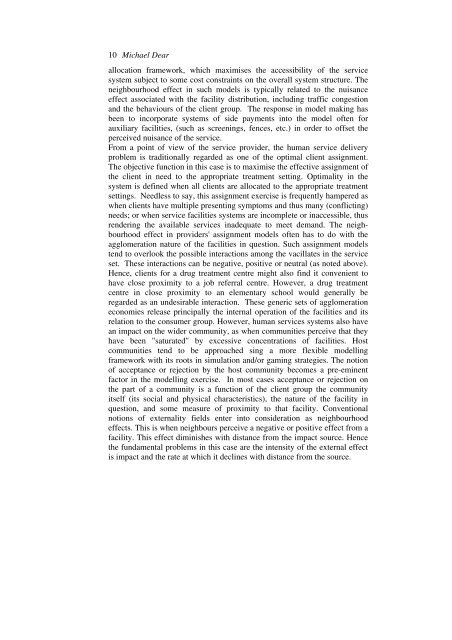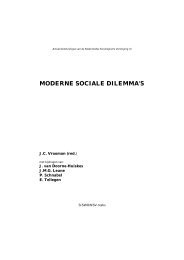de invloed van de buurt - Maatschappijwetenschappen - Universiteit ...
de invloed van de buurt - Maatschappijwetenschappen - Universiteit ...
de invloed van de buurt - Maatschappijwetenschappen - Universiteit ...
You also want an ePaper? Increase the reach of your titles
YUMPU automatically turns print PDFs into web optimized ePapers that Google loves.
10<br />
Michael Dear<br />
allocation framework, which maximises the accessibility of the service<br />
system subject to some cost constraints on the overall system structure. The<br />
neighbourhood effect in such mo<strong>de</strong>ls is typically related to the nuisance<br />
effect associated with the facility distribution, including traffic congestion<br />
and the behaviours of the client group. The response in mo<strong>de</strong>l making has<br />
been to incorporate systems of si<strong>de</strong> payments into the mo<strong>de</strong>l often for<br />
auxiliary facilities, (such as screenings, fences, etc.) in or<strong>de</strong>r to offset the<br />
perceived nuisance of the service.<br />
From a point of view of the service provi<strong>de</strong>r, the human service <strong>de</strong>livery<br />
problem is traditionally regar<strong>de</strong>d as one of the optimal client assignment.<br />
The objective function in this case is to maximise the effective assignment of<br />
the client in need to the appropriate treatment setting. Optimality in the<br />
system is <strong>de</strong>fined when all clients are allocated to the appropriate treatment<br />
settings. Needless to say, this assignment exercise is frequently hampered as<br />
when clients have multiple presenting symptoms and thus many (conflicting)<br />
needs; or when service facilities systems are incomplete or inaccessible, thus<br />
ren<strong>de</strong>ring the available services ina<strong>de</strong>quate to meet <strong>de</strong>mand. The neighbourhood<br />
effect in provi<strong>de</strong>rs' assignment mo<strong>de</strong>ls often has to do with the<br />
agglomeration nature of the facilities in question. Such assignment mo<strong>de</strong>ls<br />
tend to overlook the possible interactions among the vacillates in the service<br />
set. These interactions can be negative, positive or neutral (as noted above).<br />
Hence, clients for a drug treatment centre might also find it convenient to<br />
have close proximity to a job referral centre. However, a drug treatment<br />
centre in close proximity to an elementary school would generally be<br />
regar<strong>de</strong>d as an un<strong>de</strong>sirable interaction. These generic sets of agglomeration<br />
economies release principally the internal operation of the facilities and its<br />
relation to the consumer group. However, human services systems also have<br />
an impact on the wi<strong>de</strong>r community, as when communities perceive that they<br />
have been "saturated" by excessive concentrations of facilities. Host<br />
communities tend to be approached sing a more flexible mo<strong>de</strong>lling<br />
framework with its roots in simulation and/or gaming strategies. The notion<br />
of acceptance or rejection by the host community becomes a pre-eminent<br />
factor in the mo<strong>de</strong>lling exercise. In most cases acceptance or rejection on<br />
the part of a community is a function of the client group the community<br />
itself (its social and physical characteristics), the nature of the facility in<br />
question, and some measure of proximity to that facility. Conventional<br />
notions of externality fields enter into consi<strong>de</strong>ration as neighbourhood<br />
effects. This is when neighbours perceive a negative or positive effect from a<br />
facility. This effect diminishes with distance from the impact source. Hence<br />
the fundamental problems in this case are the intensity of the external effect<br />
is impact and the rate at which it <strong>de</strong>clines with distance from the source.















